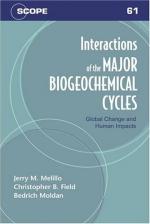|
This section contains 1,031 words (approx. 4 pages at 300 words per page) |

|
Nutrients are elements that plants require for growth. In most terrestrial ecosystems, a lack of essential nutrients may limit plant primary productivity. Net primary productivity (NPP), other ecosystem processes, and ecosystem structure and function may be best understood by examining and studying the cycles of these nutrients. To trace the movement of a nutrient—such as nitrogen (N), phosphorus (P), sulfur (S), or carbon (C)—as it travels between the living (biotic) and nonliving (abiotic) components of an ecosystem is to trace its biogeochemical cycle.
The Phosphorus Cycle
A generalized biogeochemical cycle of phosphorus, for example, starts with its release from apatite (phosphorus-containing rock). Inorganic, plant-available forms of phosphorus in most soils derive from apatite. Mechanical and chemical weathering reactions release phosphorus from apatite into the soil solution. Plants take up available forms of phosphorus, such as orthophosphate (H2 PO43-), from the soil solution into...
|
This section contains 1,031 words (approx. 4 pages at 300 words per page) |

|


